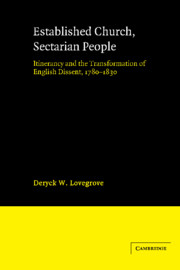 Established Church, Sectarian People
Established Church, Sectarian People Book contents
- Frontmatter
- Contents
- List of figures
- Preface
- Acknowledgements
- List of abbreviations
- 1 The Established Church and English Separatism
- 2 Itinerancy and Dissent
- 3 Preachers and sponsors
- 4 The academic leaven
- 5 Organization and infrastructure
- 6 Support and opposition
- 7 Criticism and legality
- 8 Developments and trends
- Conclusion
- Appendix A Journal of T[homas] Wastfield, June 1797–April 1798
- Appendix B Organizations active in itinerant evangelism
- Appendix C Baptismal statistics
- Notes
- Bibliography
- Index
3 - Preachers and sponsors
Published online by Cambridge University Press: 13 October 2009
- Frontmatter
- Contents
- List of figures
- Preface
- Acknowledgements
- List of abbreviations
- 1 The Established Church and English Separatism
- 2 Itinerancy and Dissent
- 3 Preachers and sponsors
- 4 The academic leaven
- 5 Organization and infrastructure
- 6 Support and opposition
- 7 Criticism and legality
- 8 Developments and trends
- Conclusion
- Appendix A Journal of T[homas] Wastfield, June 1797–April 1798
- Appendix B Organizations active in itinerant evangelism
- Appendix C Baptismal statistics
- Notes
- Bibliography
- Index
Summary
Where eighteenth- and early nineteenth-century itinerancy is recognized as a distinct phenomenon, it is invariably associated with laymen of humble origin. Contemporary critics represented the situation in similar terms, adding disparaging remarks concerning the educational deficiency of the preachers, the ill-assorted nature of their secular occupations, and their corresponding lack of suitability for any form of Christian leadership. Yet careful examination of the documentary evidence suggests that the images of lay dominance and of the inappropriateness of the personnel employed are at the best inadequate, and at the worst wholly misleading.
Encouraged by the increasing social tension of the 1790s the general Establishment attitude towards itinerants had by the turn of the century become uncompromisingly negative. Warning his clergy about the ‘conventicles’ springing up on every side, Bishop Samuel Horsley observed, ‘The pastor is often, in appearance at least, an illiterate peasant or mechanic.’ Although the educational criticism did not constitute the main point of Horsley's argument, it was a reiterated theme of contemporary polemic and was developed, for example, by Robert Woodward, Vicar of Harrold, who had experienced in his own village the activity of preachers connected with the Bedfordshire Union of Christians. ‘Though some of the dissenting teachers are men of education’, he admitted, ‘yet it is well known that many who take upon themselves to be preachers of the Gospel are uneducated.’ ‘[They are] destitute of Greek learning, the language in which the New Testament was originally written.’
- Type
- Chapter
- Information
- Established Church, Sectarian PeopleItinerancy and the Transformation of English Dissent, 1780–1830, pp. 41 - 65Publisher: Cambridge University PressPrint publication year: 1988


